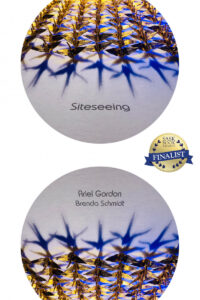By Frances Boyle
Siteseeing
by Ariel Gordon and Brenda Schmidt
At Bay Press (2023)
Siteseeking is the result of a year-long conversation in poetry between two writers celebrated for their environmental writing. When Ariel Gordon and Brenda Schmidt took on this project one year into the Covid-19 pandemic, they were “sheltering in place” in their home communities: Gordon in Winnipeg with, as she says, “a cat up each nostril” (13) and Schmidt in rural central west Saskatchewan. As they wrote poems back and forth through the seasons on a rhythm that suited their lives, what emerged was the wonderful book Siteseeing.
Birds are a perennial focus for Schmidt, a former Saskatchewan poet laureate, while Gordon is known for her writing about trees, including her collection of essays, Treed. The writers initially intended to further explore their respective subjects in relation to the environment. But ultimately the conversation ranged freely though their two landscapes. There are indeed evocations of birds and trees from both Gordon and Schmidt, but the poems also extensively feature plants and crops, family and neighbours, insects and animals, and weather. Such weather! A summer of drought, heat warnings and wildfire smoke “What if / fire season never ends? … What if / we close our eyes to everything?” (Schmidt, 68), a winter of storms where “we are running out / of places to put snow (Gordon, 143).
The poets originally envisioned their conversation as a riff on the renga, a Japanese form of call-and-response poem. However, they eschewed the specifics of that form in favour of a free-flowing exchange, largely in tercets with occasional couplets and single-line stanzas that add emphasis and even gravitas. The individual poems are distinguished by typeface (Schmidt’s poetry in italics, Gordon’s in standard type).The response aspect is sometimes overt, as when a Schmidt poem ends “I want the gold / to mean something” and Gordon’s next poem begins “I want it all / to mean something,” (65) or when “The sun is shaking / sparkles off the trees” from Schmidt is followed by “February sun through a south-facing / window spreads itself” from Gordon (151). Other times the linkages are more oblique or intuitive: writing one blizzard prompts a poem with another blizzard (125), a mention of a lilac leads to a willow (18).
Schmidt and Gordon write nature poetry but, in writing about the environment with an eye on climate change, they necessarily bring in human impacts on the wild places. A gravel truck is “farting diesel, // the driver hating our quiet existence / or loving the powerful engine / or both.” (Schmidt 150-151); “Bucket trucks & chippers now / & herbicides later. It smelled glorious, / it felt awful” (Gordon, 5).
This is poetry of sustained observation. We follow—we see!—the slow decline of a “boulevard elm” in Gordon’s neighbourhood, and the comings and goings of wildlife in Schmidt’s garden and the surrounding fields. Befitting a conversation, the language is often colloquial, but there are plenty of flashes of lyricism and sparkling imagery: “The flock [of partridges] / squints as a unit as a gust / hits their bottoms, lifts feathers/ all Marilyn Monroe.” (Schmidt, 103); “the grey / tube socks of trembling aspen / catkins” (Gordon, 19); “I have been storing the gold / of fall sunshine in my hair & the eyes / I inherited // from my father” (Gordon, 87).
Covid is a constant. There are explicit references, such as when Gordon mentions “a socially distanced hour” (60), and Schmidt hears chatter about “a cluster / of variants in the area” (23) and sees “men / unmasked & manspreading …// near the only entrance of / the vaccination clinic” (42). But the pandemic and the restrictions are most often evident in solitude, sometimes welcome but often alienating. There’s a sense of dis-ease, “a time when everything changed and everything stayed the same” as Gordon notes in the acknowledgements (161).
The physical book is compact but, at 160+ pages, it is not a “slim volume.” The poems follow one upon the other without page breaks, so the book doesn’t have the pauses that white space can bring to a collection. This makes for a rather dense but rich read on first go-through. The weeks and seasons spin out without demarcation as the reader sees the vestiges of winter retreat and a drought-plagued summer begin, then the passage of summer into fall and another winter. On subsequent readings, I found myself dipping into the book, reading a sequence or two, and reveling in the language and imagery. I began to think Siteseeing could almost be considered a “devotional,” a book to inspire contemplation, though here the subjects are the land and the environment with no religious intent. The poems are highly attentive to the sites within each writer’s view, but their unique ways of seeing make the book evocative and memorable.
Frances Boyle is the author of three poetry books, most recently Openwork and Limestone (Frontenac House, 2022). Her other books include Seeking Shade, an award-winning short story collection (The Porcupine’s Quill, 2020) and Tower, a novella (Fish Gotta Swim Editions, 2018). Recent and forthcoming publications include work in The Honest Ulsterman, Ink Sweat & Tears, Pinhole Poetry, +doc, and The New Quarterly. Originally from Regina, Frances has long lived in Ottawa. For more, please visit www.francesboyle.com and follow @francesboyle19.

